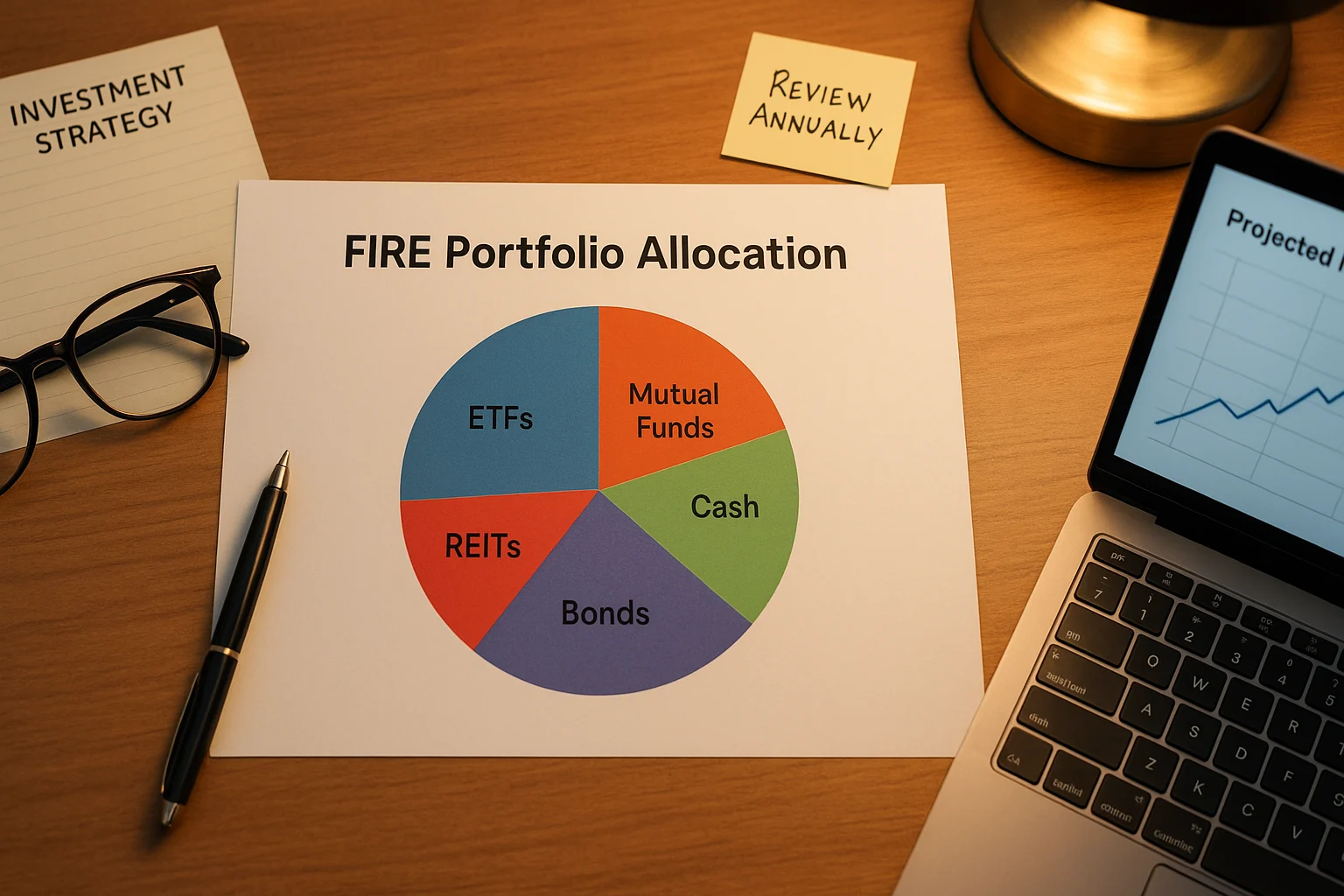
Ever wondered what it takes to ditch the 9-to-5 and retire early? The financial independence 4 rule—popular in the FIRE movement—gives you a clear way to estimate your FIRE number so you can plan life on your terms. We’ll cover how the 4% rule works, compare ETFs versus mutual funds, and include a quick calculator to crunch your numbers.
Calculate Your FIRE Number!Your Personal FIRE Number Calculator Tool
FIRE Number Calculator
Plug in your details below to see your FIRE number update instantly!
Your Estimated FIRE Number:
$0Projected Years Until Target Retirement Age: N/A
Table of Contents
- Key Takeaways for FI
- What Is the 4% Rule for FI?
- Mastering the Financial Independence 4 Rule
- Calculating Your FIRE Number with the 4% Rule
- Types of FIRE: Choose Your Path
- Building Your FIRE Savings Portfolio
- Adjusting for Reality: Inflation and Unexpected Costs
- Beyond the Numbers: Life After FIRE
- Frequently Asked Questions (FAQs) About the 4% Rule
- Conclusion: Your Journey to Financial Independence
Key Takeaways for FI
- 4% Rule Lowdown: Take out 4% of your savings every year, bumped up a bit for inflation, and you’re set to chill in retirement for 30 years or more.
- Personal FIRE Number: Take your yearly spending, multiply it by 25, and you’ve got your savings target—flexible to fit your dream lifestyle.
- Strategic Investing: Use low-cost ETFs or mutual funds for diversification and growth to hit your FIRE target.
- FIRE Variations: Choose Lean, Coast, or Fat FIRE based on your spending and retirement goals.

What Is the 4% Rule for FI?
Financial Independence (FI) means your passive income covers all living expenses, freeing you from needing a job. Retire Early (RE) is the option to stop working once FI is achieved. The FIRE movement empowers you to control your time, pursue passions, or engage in meaningful work without financial stress. It’s not just for the wealthy—with disciplined saving and investing using the 4% rule, it’s within reach for many.
Mastering the Financial Independence 4 Rule
The 4% rule suggests withdrawing 4% of your portfolio annually, adjusted for inflation, to fund a 30-year retirement with high confidence.
Origin of the Financial Independence 4 Rule
The 4% rule stems from the 1998 Trinity Study by Trinity University professors, analyzing historical market data. It found a 4% withdrawal rate sustained portfolios through most 30-year periods. Learn more about the study.
“The 4% rule is a robust guideline based on historical data, ideal for FIRE planning.”
How the 4% Rule Works for Financial Independence
Here’s how it operates:
- Initial Withdrawal: Withdraw 4% of your portfolio in year one.
- Inflation Adjustment: Increase withdrawals annually for inflation (e.g., $40,000 becomes $41,200 at 3% inflation).
- Portfolio Growth: The remaining 96% stays invested, aiming to outpace inflation and withdrawals.
The 25x Rule: Your Financial Independence Target
The 4% rule implies your portfolio should be 25 times your annual expenses (e.g., $40,000 x 25 = $1,000,000). This “25x rule” is your FIRE number, enabling indefinite withdrawals with proper investing.
Calculating Your FIRE Number with the 4% Rule
Figuring out your FIRE number turns those big retirement dreams into something you can actually measure and chase after.
Step 1: Estimate Your Annual Expenses
Your FIRE number all comes down to what you spend. For 3–12 months, keep tabs on your expenses using a budgeting app or your bank statements with tools for tracking your spending. Break them down into categories like housing, groceries, healthcare, and travel. Split your spending into must-haves (like rent or utilities) and nice-to-haves (like dining out). Then, think about what your retirement might look like—maybe your mortgage will be paid off, or you’ll spend more on trips. Factor in taxes, as withdrawals may be taxable. For example, if your current expenses are $60,000, subtract $18,000 for a paid-off mortgage, and add $5,000 for travel, you’d land at $47,000 a year.
Step 2: Choose Your Withdrawal Rate
The 4% withdrawal rate is the go-to for most, but if you’re planning a super long retirement, 3.5% or even 3% might feel safer. Going lower means your savings are less likely to run dry, but you’ll need a bigger nest egg to start with.
| Withdrawal Rate | Multiplier | FIRE Number Impact |
|---|---|---|
| 4% | 25x | Standard for 30+ years. |
| 3.5% | 28.57x | Higher safety margin. |
| 3% | 33.33x | Maximum security. |
Step 3: Apply the 25x Rule
Formula: FIRE Number = Annual Expenses x Multiplier. For $47,000 at 4%, it’s $47,000 x 25 = $1,175,000. At 3.5%, it’s $1,342,790. Adjust based on how safe you want to play it.

Types of FIRE: Choose Your Path
FIRE offers different paths to match your lifestyle and goals, each with its own mindset.
Lean FIRE
Overview: Living simply with low expenses using a straightforward 4% withdrawal guideline. Ideal for: Folks who love keeping things minimal. Mindset: Value freedom over stuff, focusing on what truly matters. Example: $30,000 annual expenses x 25 = $750,000.
Coast FIRE
Overview: Save a chunk early, then let your investments grow to your FIRE number by traditional retirement age. Ideal for: Those wanting flexibility later. Mindset: Work hard now for freedom down the road. Example: $300,000 at 35 grows to $1.5 million by 60.
Barista FIRE
Overview: Work part-time to cover some expenses, easing the load on your savings. Ideal for: People who want a gradual step into retirement. Mindset: Blend a bit of work with lots of leisure. Check out Barista FIRE strategies. Example: $50,000 expenses, $20,000 from work, portfolio covers $30,000 ($750,000).
Fat FIRE
Overview: Retire with a big budget for a luxurious lifestyle. Ideal for: Those who love the finer things. Mindset: Enjoy comfort and indulgence without worry. Example: $150,000 expenses x 25 = $3,750,000.
Building Your FIRE Savings Portfolio
Investing—guided by the 4% rule—is the engine that powers your FIRE journey, using compound interest to grow your wealth.
Compound Interest Power
Your money grows on itself—returns pile up on your original investment, creating serious growth over time. For example, $10,000 at 7% turns into $11,449 in just two years. Start early, and the rewards are huge!
ETF vs. Mutual Fund for Financial Independence
ETFs and mutual funds both spread your money across lots of assets, but they’ve got different vibes. Curious about low-cost index funds? They’re a FIRE favorite.
Mutual Funds
Pros: Pros handle the investing, you get diversification, easy auto-investing, and they’re often in 401(k)s. Cons: Higher fees, limited trading times, sometimes extra sales charges.
Exchange-Traded Funds (ETFs)
Pros: Low fees, trade anytime, tax-friendly, clear holdings. Cons: Might have trading costs, less hands-on management.
Best Choice
Low-cost index ETFs, like those tied to the S&P 500 with 0.03% fees, are a FIRE go-to for their affordability and broad coverage. Mutual funds work if your 401(k) has cheap ones.
Diversification and Rebalancing
Mix your investments—say, 70% stocks, 20% bonds, 10% real estate—to keep risks low. If one area tanks, others can hold steady. Every so often, rebalance (like shifting from 85% stocks back to 80%) to stick to your plan.
Adjusting for Reality: Inflation and Unexpected Costs
The 4% rule plans for real-life twists like inflation and surprise expenses.
Inflation
Inflation makes stuff cost more over time. The 4% rule bumps up your withdrawals to match (e.g., $40,000 to $41,200 at 3% inflation). Stocks help your money grow faster than inflation. Your own costs, like healthcare, might rise quicker than average.
Contingency Funds
Keep a 3–6 month emergency stash for things like home repairs, healthcare costs before Medicare, or market slumps. Set aside 5–10% extra for fun or unexpected stuff. If the market dips, cut back on extras like fancy dinners to keep your savings safe.
Beyond the Numbers: Life After FIRE
Reaching your FIRE goal with the 4% rule unlocks a life built around what truly matters to you.
- Your Time: Take off on adventures, launch a dream project, volunteer, or just hang out with loved ones.
- Staying Engaged: Try new hobbies, pick up a fresh skill, or jump into things that spark joy and keep you energized.
- Identity Shift: Prepare to rediscover yourself when work’s no longer the center of your world—it’s a big leap, but such an exciting one!
Frequently Asked Questions (FAQs) About the 4% Rule
Conclusion: Your Journey to Financial Independence
The 4% rule makes retirement feel achievable. Save consistently, prioritize low-cost funds, and keep spending intentional. Revisit your plan yearly so your strategy evolves as life does.
This content is for informational purposes only and not financial advice. Consult a professional before making financial decisions.

